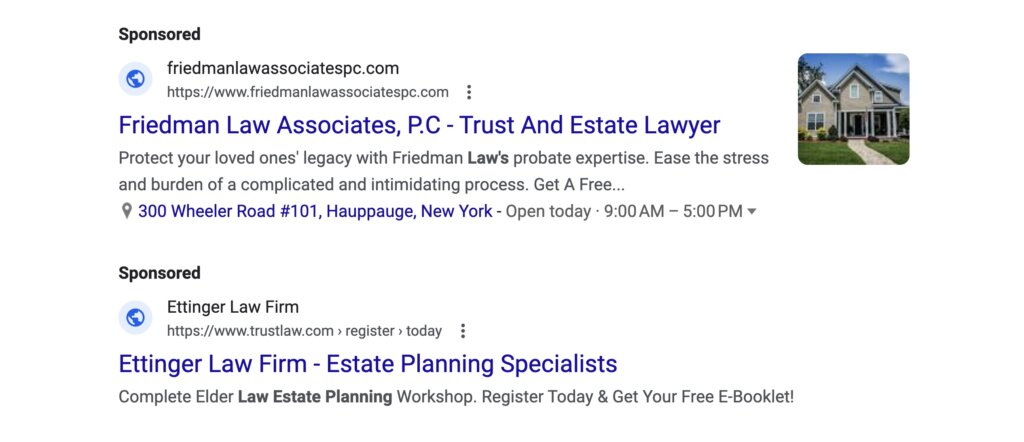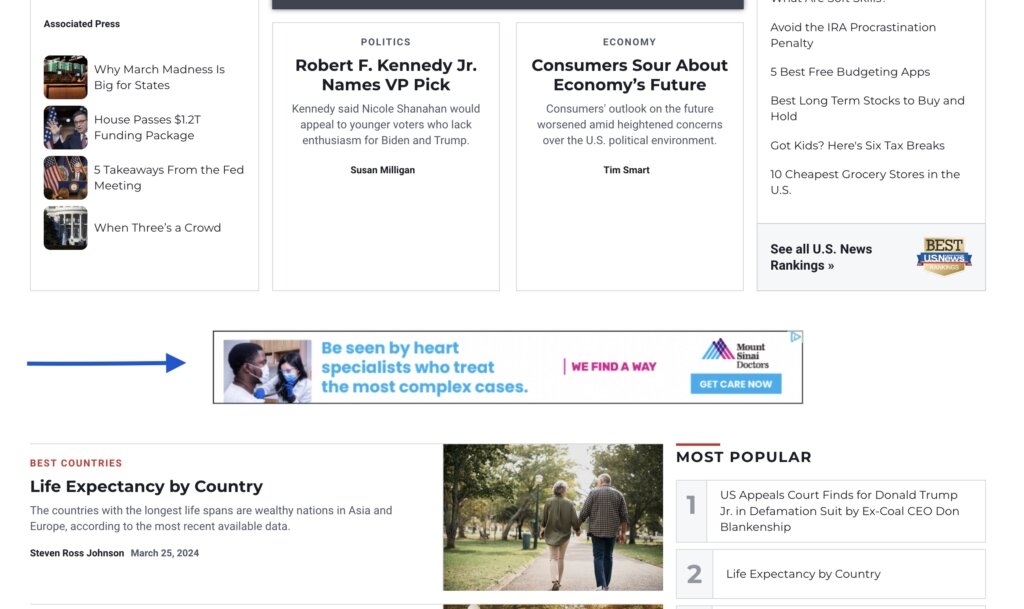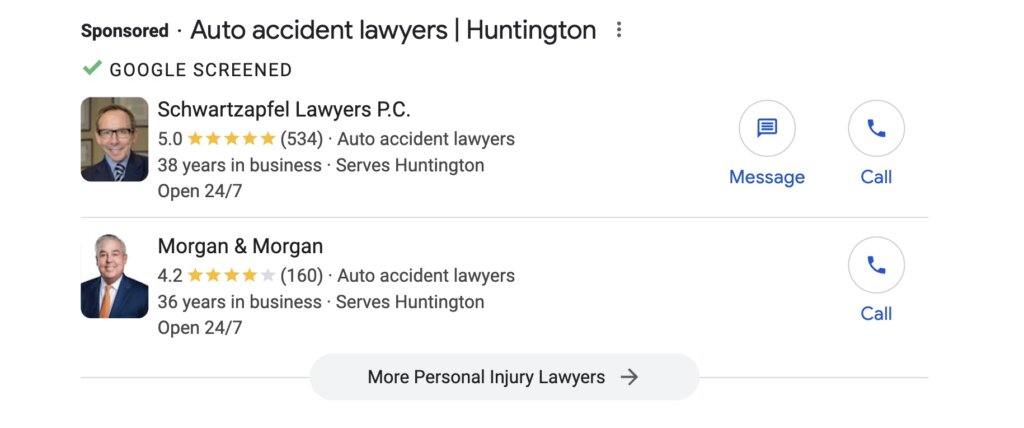When most people think of Google Advertising, they think of standard PPC ads. But there are more ad types in Google’s ecosystem—including cheaper ads which, in some cases, may have a higher ROI.
Here’s what you need to know about Google Ads in 2024, including which Google Ads are best for lawyers.
PPC ads are great, but Google has more to offer
There’s no doubt that PPC ads are valuable to lawyers. These ads get you exposure to your target clients and help deliver qualified prospects to your doorstep.
- Paid search ads can increase brand awareness by up to 80%.
- Businesses that use Google Ads earn (on average) $8 for every $1 spent.
However, PPC ads also come at a cost—in fact, legal services are one of the most competitive and expensive industries for PPC.
The good news is that you have more choices in the Google ecosystem beyond PPC ads.
The 7 basic types of Google Ads (the first 5 are most relevant)
Here’s what you need to know about each of the Google Ad types to determine if they can help grow your firm.
1. Search ads

Location: Top or bottom of the SERP
Cost per lead (CPL): High
First, you decide on the keywords you want to bid on based on your searchers’ queries. Then, you create an ad. If you are the highest bid in the auction, your search ad will appear in the Google search results when someone searches for those specific keywords. These are a type of pay per click ad.
Purpose: Search ads catch people who are ready to take action.
2. Display ads

Location: Images and banners anywhere in Google’s Display Network
Cost per lead (CPL): Medium
Display ads are visual: videos, images, animations, or other rich media. These ads appear when people are casually browsing as a banner or image somewhere on a site they normally visit. Ads do not pop up based on specific searches, but they can be set to target specific users by interest and demographics. These are a type of PPC ad.
Purpose: Display ads can increase brand awareness.
3. Video ads
Location: In video content on YouTube or anywhere in Google Display Network
Cost per lead (CPL): Low
You’ve probably seen ads on YouTube content—these are Google video ads. Google owns YouTube! A video ad can appear in the middle of content, after, or as a pre-roll ad. The strategic part of video marketing is deciding which categories of videos, channels, keywords, or time of day you want to prioritize. For instance, a personal injury lawyer specializing in car accidents could place video ads on channels that focus on car safety, auto repair, insurance, or local news websites. These are a type of PPC ad.
Purpose: Video ads build trust and generate brand exposure through engaging visuals.
4. Local Service Ads

Location: Top of the SERP
Cost per lead (CPL): High
Local ads appear when a nearby person is searching for local services or if the person is physically located in the geographic area you’re targeting. Your Google Local Service Ad may pop up right above the Google Map Pack. With this form of advertising, you are paying per lead rather than by click or impression.
Purpose: Local Service Ads increase visibility and generate leads from local searchers.
5. Demand Gen ads (formerly known as Discovery ads)
Location: Throughout Google’s online properties
Cost per lead (CPL): Low
Have you noticed any sponsored ads appearing in your Gmail? How about in your YouTube home feed? These are AI-driven placements for video and image ads that pop up when someone is searching for related content. The users are not driven by any specific search intent, but the intimate location nestled next to someone’s emails and their YouTube subscriptions is hard to beat.
Purpose: Demand Gen ads use artificial intelligence to reach people at scale.
6. App ads
Location: Anywhere in Google’s network
Cost per lead (CPL): High
Purpose: App ads promote the download of a specific mobile app.
7. Shopping ads
Location: Google’s search results page
Cost per lead (CPL): Low
Purpose: Shopping ads allow people to click directly on a Product Listing Ad (PLA) within the SERP. These ads have everything a product listing has: photo, price, and product description. The link takes them to the purchase page for a physical product. These are a type of PPC ad.
To manage your Google Ads, you might use a tool like Smart Campaigns or PMax (Performance Max). PMAX is an expensive tool but it allows you to tap into machine learning to automatically target and adapt a variety of Google Ads.
How Google Ads can help your firm grow
Grow your caseload with clever Ads? It’s true. Here are four ways Google Ads for lawyers can help you grow.
+ Ads help with mobile visibility
Google Ads get very high visibility on mobile devices, where most service research begins. Ads appear before local map packs and organic results, making them hard to miss. Ads can help boost your visibility with people on their smartphones, attracting more potential clients to your law firm’s website.
+ Ads help with targeting
Google Ads empower you to do precise targeting, ensuring that your ad spend reaches people seeking specific services. To increase the quality of your traffic, use niche-specific terms like “DUI lawyer in Los Angeles” rather than “lawyer”. You can also use negative keywords and exclude certain audiences to avoid spending your ad money on people who likely won’t be interested.
+ Ads help you with data-based brand building
You can buy Google Ads for your firm’s name to avoid competitors who want to hijack those searchers and redirect traffic to their own sites. Of course, branded searches indicate high buyer intent but that’s no guarantee! Google Ads are a powerful way to claim your brand’s real estate on Google more extensively, all while providing accurate data to direct your spending and achieve your conversion goals.
+ Ads may help with cashflow
Whereas organic SEO takes months to deliver results, Google Ads can produce an influx of clients and generate some cash flow faster. While results of an Ads campaign are often faster than the results realized from SEO, t’s important to note that most firms won’t see real revenue for ads for 3-6 months.
Should I invest in Ads for my firm?
Ads can turbocharge growth for some firms. Google claims that businesses make about $2 in revenue for every $1 spent on Google Ads.
The effectiveness of Google Ads depends on your firm’s specialization and clientele.
Some practice areas (like M&A, estate planning, real estate) get more referrals based on word-of-mouth and relationships. These firms need to be strategic about pursuing Google Ads.
Legal fields with more stigma, like DUI, bankruptcy, or criminal law, will benefit more from investing in Google Ads. Privacy concerns may prevent your target clientele from speaking to their friends and colleagues—but they’ll turn to a search engine for help.
The timeline for seeing results with Google Ads
It takes time to build a campaign. It takes even more time to analyze the results and optimize your Google Ads for peak performance.
Expect your first batch of results from Google Ads in a few weeks. Then, know that your ads campaigns will mature over the course of months as you tweak and improve.
Think long-term about ROI with Google Ads and you’ll get your money’s worth.
Additional resources
- SEO for Lawyers in 2024
- Digital Strategy Planning for 2024
- Offline and Online Advertising—They’re a Team!
- Primer on Google’s Helpful Content System
- Google or Bing, or Both?
- What’s Right for My Firm? SEO vs. SEM
Review and next steps
Reach out for a consultation if you’d like an outside opinion on your firm’s digital marketing strategy. We specialize in serving growth-oriented law firms and we consult and deliver on website design, organic SEO, and paid marketing campaigns.

